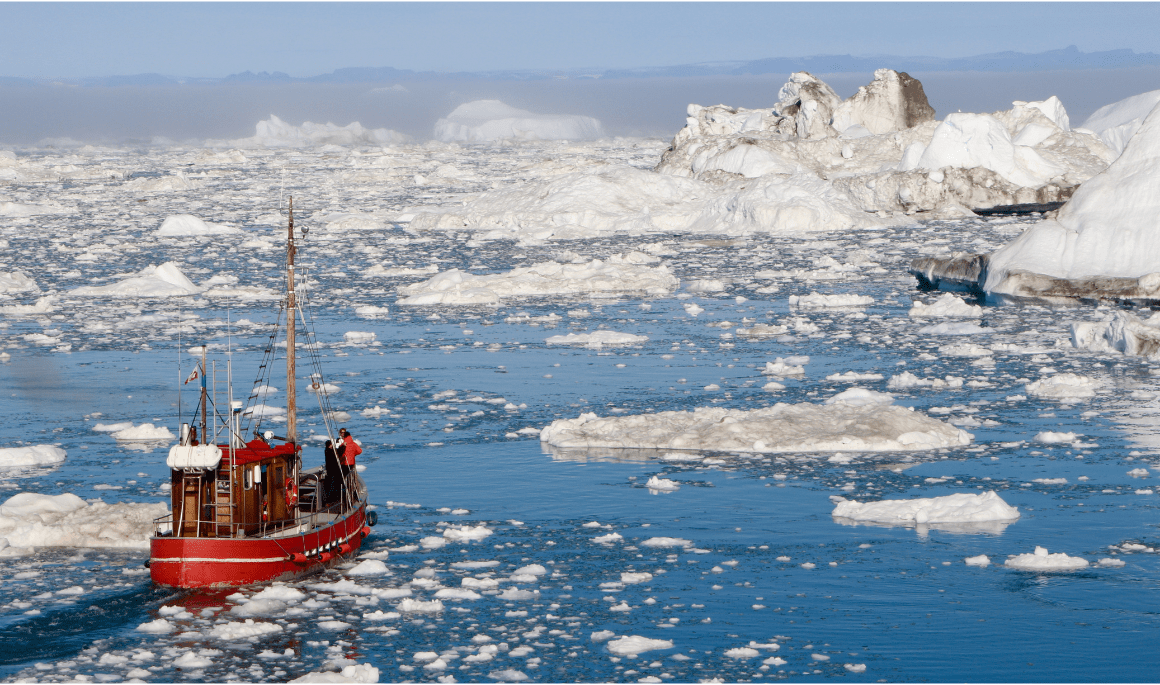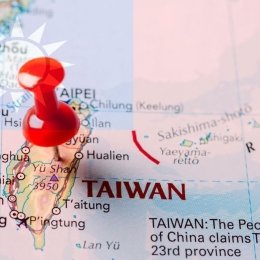- Norwich Blogs
- Blogs
- From Continental Shelves to Cruise Missiles: Strategic Rivalries in the Arctic
From Continental Shelves to Cruise Missiles: Strategic Rivalries in the Arctic
This article examines how melting Arctic ice has spurred geopolitical competition over seabed claims and trade routes. Notably, Russia has capitalized on thawing conditions—and weakening Western deterrence—to escalate military presence, including the deployment of nuclear-capable Tu-95 “Bear” bombers armed with long-range cruise missiles near Alaska.

Disclaimer: These opinion pieces represent the authors’ personal views, and do not necessarily reflect the official policies or positions of Norwich University or PAWC.
Since the early 2000s, the Arctic has become a hotbed of military and economic activities. The uneventful 1990s in the great white north were replaced by the resumption of seabed explorations for economic claims, research expeditions, and military buildup. The two factors have contributed to the emergence of the Arctic as a venue for a new international competition: the warming up of the Arctic and the rise of the Putin regime in Russia. Warmer sea temperatures have seasonally reduced the area covered by the sea ice so that hitherto closed navigation routes have become navigable in most summers. In a parallel development, the Arctic nations have become engaged in disputes to demarcate continental shelves and exclusive economic zones. These developments, combined with increasingly appeasing Western policies toward Russia, have inspired Moscow to offer more aggressive policies and show of force in the Arctic.
On February 7, 2024, two Russian long-range bombers, escorted by Russian SU-30 fighter jets, were “detected and tracked” near the coast of Alaska. The Cold War-era Tu-95 strategic aircraft equipped with nuclear warhead-capable cruise missiles reportedly flew about nine hours, covering a considerable distance in the Arctic. The modernized all-weather “Bear” bomber carries up to six X-101 cruise missiles with a range of up to 5,000 kilometers (about 3,100 miles). Apparently, the Russian aircraft did not enter American or Canadian airspace, which they did not have to if the purpose of their exercise was a mock attack on North America with nuclear cruise missiles. With a cruise missile range of 3,100 miles, Tu-95 can remain in the Bering Straits, international waters, and attack all of the West Coast, large parts of the Midwest, and most of Canada, not to mention Alaska.
This visit was not the first foray by Russia’s long-range Air Force into North American airspace. Common during the Cold War and virtually non-existent in the 1990s, in 2007, the Putin regime slowly resumed mock attack flights now performed by restored and modernized Cold War-era bombers. The Arctic has become a hotbed of military activities under President Putin. Russians are using nuclear icebreakers to guide merchant ships through the eastern Arctic passage, mounting expeditions and establishing permanent research stations, building floating nuclear power stations, conducting long-range bomber flights, continuing the development of a new generation of nuclear submarines, and performing submarine-launched long-range ballistic missile tests in the region.
The renewal of Russian military undertakings in the Arctic has coincided with various international disputes among the Arctic nations in the background. These disputes have often been characterized as “geopolitical rivalries” and sometimes called “territorial disputes.” They might be geopolitical, but these disputes are not “territorial” as such. Under international law, “territory” refers specifically to dry land, while the Arctic disputes are about economic exploration of seabed, continental shelves. The largest and the most significant among these is the dispute over the Lomonosov Ridge between Russia, Canada, and Denmark.
Russia has not used force to strengthen its claim for the 1,100-mile-long Lomonosov Ridge yet. So far, Moscow has followed the international UN format to settle the dispute, aided by civilian research deployments in the high Arctic. In January 2024, the United States submitted to the UN its claim over an extended continental shelf in the Arctic off the northern coast of Alaska. No other country claims this area roughly the size of Texas. Ironically, the United States has yet to ratify the UN Convention on the Law of the Sea (UNCLOS), the 1982 UN treaty, which is expected to legitimize this claim.
For Canada, the Lomonosov Ridge is not the only dispute in the Arctic. It has recently settled one dispute with Denmark, which claimed the possession of Hans Island through Greenland. Hans Island, a barren rock barely a mile across, had been the subject of a friendly dispute between two NATO allies for years. The most drastic act Canadian and Danish sailors resorted to was to leave their favorite bottle of alcohol when sailing by Hans Island. Thus, Danes collected a good number of rye whiskey bottles during the dispute years, and Canadians got Danish booze with roughly equal strength of alcohol. Eventually, the two countries concluded the conflict fought with booze as the primary weapon by agreeing to divide the tiny rocky island between them.
America’s closest friend and ally, Canada, has two other disputes, both with the United States. One is trivial and relatively insignificant – it deals with a section of maritime boundary between Alaska and Yukon. The other is more noteworthy as it could have security implications for both countries. The famous Northwest Passage, covered with sea ice, was impassable until 1969 when the SS Manhattan crossed it. The largest ship in the U.S. merchant fleet at that time barely remained intact and never tried it again. Regardless, the Manhattan voyage caused a sizable consternation in Canada: legally, the Northwest Passage is international waters, but since it was almost always covered with ice, for Canada, it represented a continuous surface connecting Arctic Canadian islands.
Since the Manhattan voyage, Ottawa has been in talks with Washington to somehow designate the Northwest Passage as belonging to Canada or Canada as its guardian. Canadians even came up with a novel legal claim that it was Canada’s “historic waterways.” Washington has so far refused to concede that the Northwest Passage is anything but international waters. This, however, may not be a smart course of action moving forward as with warmer Arctic weather, most summers, the passage is free of ice. A legendary route for mariners, the Northwest Passage has now become open to anyone who is eager to try luck. Canada has minimal presence there, with only a handful of Arctic aboriginal communities and a couple research stations for the route, which is more than 1,900 miles long. If the Northwest Passage remains international waters, it is only a matter of time before Russian or Chinese warships appear there.
The war in Ukraine has reduced Russian military exploits in the Arctic. However, there are many reasons to suspect that if Moscow succeeded in Ukraine, the world should expect more decisive Russian claims in the Arctic, not only there. The Arctic is especially attractive for the nations claiming parts of it since the region is believed to be holding vast stores of unexplored mineral resources. With the advances in seabed mining technology and regresses in ice coverage it is expected that the coming decades will see massive industrial enterprises covering the region.
The post-incident report about North American Aerospace Defense Command (NORAD) having “detected and tracked” Russian bombers close to American and Canadian borders in the Arctic is not reassuring. Remote detection and tracking will not demonstrate force capability with the Russians. It appears that the North American aerospace command regards the Russian nuclear-capable aircraft approach as business as usual, but it is anything but. Russian long-range aircraft capabilities, now equipped with long-range cruise missiles, changed tremendously since the 1990s. Therefore, if American or Canadian jets were to intercept and accompany the incoming Russian bombers regularly rather than passively detect and track, the Russian Air Force would receive a qualitatively more convincing message.
If, during the Cold War, the Russian strategic aircraft could only deliver “dumb” bombs guided by nothing but gravity or primitive cruise missiles, now they can launch precision-guided and maneuverable cruise missiles that can hit any target in North America within a 3,100-mile radius. The contemporary tracking and detection technology will detect the launch of cruise missiles but will be unable to track the cruise missile paths. Low-flying cruise missiles also have the ability to remain undetected by ground radars.
The recent NORAD statement noted that “the Russian aircraft remained in international airspace” and that “Russian activity in the Alaska ADIZ occurs regularly and is not seen as a threat.” The statement did not say whether NORAD detected X-101 missiles carried by the Russian bombers – they cannot fit inside, but they are attached under the wings of the Tu-95 aircraft. Regardless, if the United States and Canada were to limit their challenge to the visiting Russian strategic bombers with remote monitoring, there is a good reason to expect such visits to continue and become more brazen.
Lasha Tchantouridze, PhD, is Professor and Director of the graduate programs in international affairs, Norwich University—The Military College of Vermont. He is also a Davis Center Associate, Harvard University, Boston, MA; Research Fellow, the Center for Defence and Security Studies, University of Manitoba, Winnipeg, Canada; and Advisory Board Member of Peace & War Center at Norwich University, and a senior research fellow at the Institute for National and International Security (INIS), Belgrade, Serbia.



